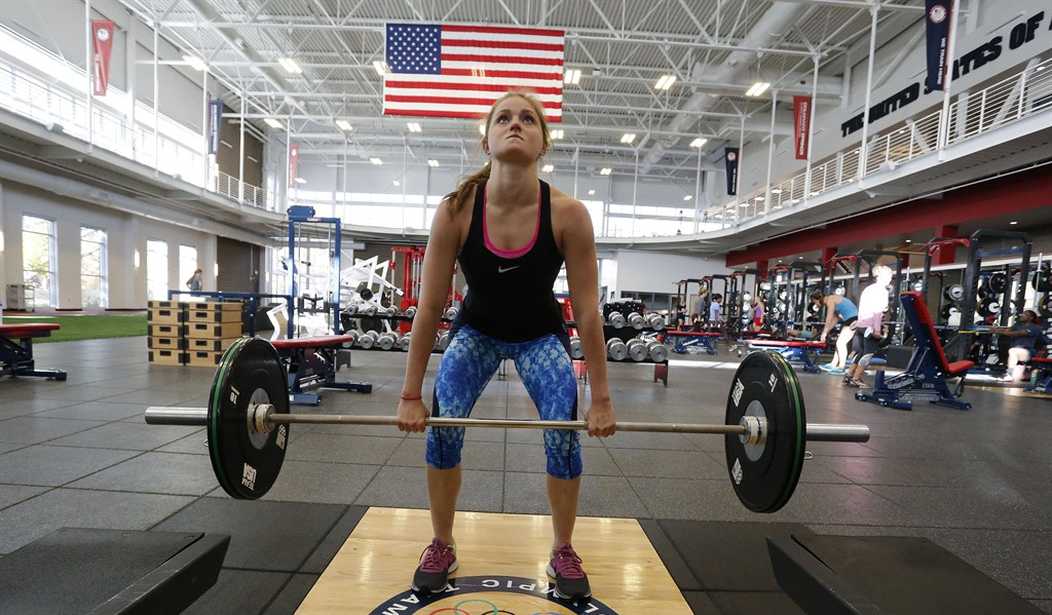The gym is my safe space. After a long day mired in politics, I look forward to getting away from the news and focusing on getting strong and healthy. No one talks about politics at my gym, no one demands to know my political affiliation, and there are no awkward conversations about divisive topics.
That's the way I like it. Unfortunately, you can run, but you can't hide from politics. The same people who like to yelp about conservatives wanting to be in their bedrooms will hunt you down and find you if you refuse to toe the line on gender denialism.
Now, it appears that barbells have become problematic to the gender-obsessed crowd. This came to my attention via a Facebook post in a private group. A CrossFit coach shared that a female who attended his class freaked out after he mentioned that the gym had both men's and women's barbells and suggested the latter might be a better fit for her. The woman got angry, accused him of discrimination, and went to the gym owner to complain about said discrimination.
For those unfamiliar with barbells, "men's" bars weigh 20 kg in the U.S. and have a greater diameter than the 15-kg "women's" version. There's no rule that women can't use men's barbels or vice versa, but most women, even the really strong ones, prefer the bar with the narrow grip to accommodate their smaller hands for "pulling" lifts, especially those requiring a hook grip.
Apparently—and previously unbeknownst to me—there is a movement to stop calling them men's and women's bars. Last September, Gabrielle Kassel wrote an article at Morning Chalk Up (a CrossFit-themed site) titled "The Case for Moving Away from 'Gendered' Weights." She cites Alyssa Royse, a CrossFit gym owner and radical social-justice activist.
But “gendering” a barbell is not only inaccurate, it’s also just plain silly.
That’s why activist and the owner of Rocket Community Fitness, Alyssa Royse, urges CrossFit box owners and coaches to designate barbells and prescribed weights in different–actually helpful ways.
“Barbells don’t have genders, they have weights,” she explains. Ditto goes for plates, kettlebells, and dumbbells.
People of any gender can use any weight barbell—so long as they have the requisite strength to move it well and safely, she says.
Calling the heavier, 45-pound barbell a “men’s” barbell and the lighter, 35-pound barbell the “women’s barbell” suggests that all men are stronger than all women, says Royse.
"But that’s not the case," Kassel insisted, "and it’s physically dangerous to imply such."
“Anyone who has ever stepped foot into a CrossFit box knows that there are absolutely women in a CrossFit class who out-lift men in a CrossFit class,” Royse says. She adds, without a shred of embarrassment for her weak husband, “My daughter, for example, can out-lift my husband any day of the week.”
The addition of lighter, narrower bars in gyms was initially touted as an innovation when it was introduced into the sport of weightlifting in 1997—you know, progress!—but now it's a tool of oppression.
There's actually a lot of science behind why the women's bars are lighter—none of it related to women being weaker (even though that's settled science). Mark Rippetoe discusses it in detail here. Basically, the narrow bars had to be made lighter because of "whippiness." [Emphasis added]
There were several variables involved in developing the Women's Division equipment. If the weight of the bar was left at 20kg, a skinnier bar would have to be longer, and therefore more whippy. Whippiness is an advantage to a lifter who knows how to use a springy bar, and this would have given the Women's Division an equipment advantage. Adjustments had to be made so that the barbells in the two divisions performed in an equivalent manner.
A group of very bright guys got together and decided that if they cut the total length of the bar down a little, and reduced the length of the sleeves (since lighter weights and fewer plates would be used by the ladies), they could make a bar that would accommodate a smaller hand at 25mm, whip like the regular 20kg bar which is 28.5mm diameter and 220cm (about 7'3") in length, while still accepting standard diameter Olympic plates. Maintaining the same plate inventory was important, since nobody could afford to buy a bunch of new plates for the ladies. In contrast, the new special purpose deadlift bar is 230cm/7'6½" long at 27mm, because it is designed to flex quite a bit before the plates leave the floor.
The women's bar has nothing to do with discriminating against women. It simply ensures that men and women have a level playing field—that equality business the left used to value, which has since been replaced by equity.
It's not an insult to recommend that a woman use a bar that fits her natural biological proportions. Men's hands, on average, are 15-20% larger than women's, so a bar with a smaller diameter is more comfortable and safer for pulling lifts where a hook grip is required. (Rippetoe recommends the women's bar for snatches and clean-and-jerks but not for pushing lifts like bench presses.) It's no different than allowing athletes to wear shoes that fit.
But it's 2024, and every perceived slight must be viewed as a hair-on-fire crisis by people whose sole aims in life are to get attention and shove their radical beliefs down everyone's throats.










Join the conversation as a VIP Member